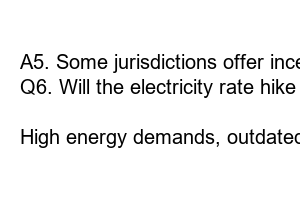전기요금 인상
Title: The Shocking Increase: Navigating the Electricity Rate Hike
Introduction:
Are you feeling the current surge in electricity bills? Lately, many households have noticed a concerning spike in their energy expenses. In this blog post, we delve into the reasons behind the electricity rate hike, offer tips to mitigate the impact, and shed light on frequently asked questions to empower you in this electricity consumption era.
1. The Rising Demand:
With the advancement of technology and increasing reliance on electronic devices, the demand for electricity has soared. Not only do we depend on it for lighting and heating, but we now require power for charging our smartphones, laptops, and other gadgets. This surge in electricity usage has put strain on the grid, leading to increased rates.
2. Depreciating Infrastructure:
The aging infrastructure is another factor contributing to the electricity rate hike. As power plants and transmission lines age, they become less efficient, leading to increased maintenance and repair costs. These expenses are eventually passed on to consumers, driving up the electricity tariffs.
3. Green Energy Transition:
In a bid to combat climate change, many regions are swiftly transitioning to greener energy sources. While this is a positive step, the initial investment needed to set up renewable energy infrastructure is significantly higher. This investment burden ultimately impacts the consumer, causing a temporary increase in electricity rates until the transition process stabilizes.
4. Fluctuating Fuel Costs:
The cost of fuel used for electricity generation can be influenced by various geopolitical and economic factors. Fluctuations in the oil, gas, or coal prices directly impact the electricity rates, as these resources are integral to power generation methods. Hence, changes in fuel costs can cause a corresponding spike in your electricity bills.
5. Energy Conservation Tips:
To mitigate the impact of the electricity rate hike, consider implementing these energy-saving tips:
– Unplug idle electronic devices and appliances.
– Switch to LED light bulbs.
– Opt for energy-efficient appliances.
– Use natural light and ventilation whenever possible.
– Regularly maintain and clean your HVAC system.
– Consider installing solar panels or invest in renewable energy sources.
6. Frequently Asked Questions (FAQs):
Q1. Will the electricity rate hike be permanent?
A2. While the current hike may be temporary, it is always wise to conserve energy and explore energy-efficient options to lower your bills in the long run.
Q2. Are there any subsidies available for low-income households?
A2. In some regions, there are subsidy programs available for low-income households. Contact your local energy provider or government agencies for information specific to your area.
Q3. Can I negotiate a lower electricity rate with my provider?
A3. It may be possible to negotiate a lower rate or explore alternative pricing plans with your electricity provider. Contact them to discuss any available options.
Q4. How can I accurately monitor my electricity usage?
A4. Consider installing a smart meter or using energy monitoring apps that provide real-time data on your electricity consumption.
Q5. Are there any incentives for adopting renewable energy sources?
A5. Some jurisdictions offer incentives such as tax credits or rebates for adopting renewable energy sources. Research your local regulations and incentives to explore such possibilities.
Q6. Will the electricity rate hike affect businesses as well?
A6. Yes, businesses will also witness an impact due to the electricity rate hike. Energy conservation and exploring alternate energy sources can help them reduce costs and increase profitability.
Summary:
High energy demands, outdated infrastructure, green energy transitions, and fluctuating fuel costs collectively account for the recent electricity rate hike. While the hike may be temporary, proactively implementing energy conservation measures and exploring renewable energy options can help mitigate its impact. By becoming knowledgeable about the factors driving the rate increase, consumers can better adapt and make informed choices for a sustainable future.

